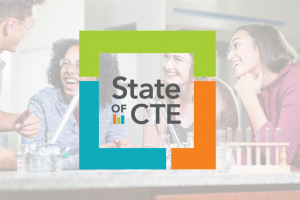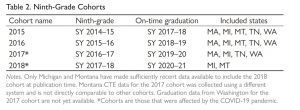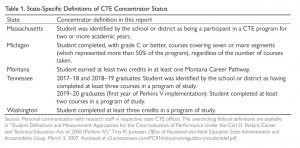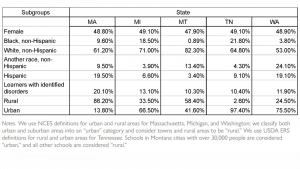Advance CTE’s newly released 2023 State of CTE: An Analysis of State Secondary CTE Funding Models highlights how states and the District of Columbia provide high-quality Career Technical Education (CTE) through various secondary CTE funding models and approaches. This blog, the second in a series, describes ways to use the website and supporting resources.
Overview
 This resource builds on baseline research conducted in 2014 by RTI International, with the support of Advance CTE, on behalf of the U.S. Department of Education, and is generously supported by the Walton Family Foundation. Advance CTE is committed to supporting states as they design equitable funding models that direct funding where it is needed most, as described in Without Limits: A Shared Vision for the Future of Career Technical Education (CTE Without Limits). Expanding knowledge about funding models and approaches for state secondary CTE is critical for state leaders to provide high-quality CTE for diverse learners. The website consists of an executive summary, research report and three case studies, interactive national funding landscape map and downloadable state-by-state funding table. Below are tips on using and sharing this research with your colleagues and stakeholders, with links to the resources in each header.
This resource builds on baseline research conducted in 2014 by RTI International, with the support of Advance CTE, on behalf of the U.S. Department of Education, and is generously supported by the Walton Family Foundation. Advance CTE is committed to supporting states as they design equitable funding models that direct funding where it is needed most, as described in Without Limits: A Shared Vision for the Future of Career Technical Education (CTE Without Limits). Expanding knowledge about funding models and approaches for state secondary CTE is critical for state leaders to provide high-quality CTE for diverse learners. The website consists of an executive summary, research report and three case studies, interactive national funding landscape map and downloadable state-by-state funding table. Below are tips on using and sharing this research with your colleagues and stakeholders, with links to the resources in each header.
Executive Summary
Read the executive summary to get a background of CTE funding foundational basics, a project overview and recommendations for revising and implementing more equitable funding models. This is a great resource for you to pass along to policymakers, legislative staff, state budget staff, partner agencies or local CTE leaders in your state. Consider adding the summary as a pre-reading assignment or an agenda item during your next meeting about state funding.
Research Report and Case Studies
The research report provides a 50-state landscape of state secondary CTE funding, highlights key trends in state funding models, and provides recommendations to advance equitable, learner-centered funding designs. You can learn about some of the ways states made adjustments to their models in the past decade and read examples of how states have designed elements of their funding models to address CTE program quality, access and completion. Case studies from Massachusetts, North Dakota and Texas showcase how three states implement different categorical funding models.
These case-use examples provide ideas for you to maximize the website and supporting resources in conversations about CTE funding.
National Funding Landscape Map
The interactive map provides a comparison of secondary CTE models across all 50 states and the District of Columbia. Identify your state’s funding model and then compare it to other states with the same funding model. You can also compare your state’s allocation to other states with similar demographics and CTE learner participation numbers. Use the information for benchmarking purposes when discussing – or advocating for – secondary CTE funding in your state.
State-by-State Funding Table
The state-by-state funding table provides descriptions of each state’s funding approach, allocations from fiscal year 2022 and sources for legislative and regulatory documents. You have the option of downloading the table for additional analysis. Run keyword searches in the descriptions for “enrollment” or “average daily membership” or “ADM” to identify how states structure funding around learner enrollment. Run a keyword search for “grants” to identify which states are using competitive or one-time grants to support secondary CTE. Compare models and approaches from 2012 and 2022 to identify states that have changed their model and/or approach in the last decade. This is helpful information to reference if your state is considering or is in the process of changing its secondary CTE funding model and/or approach.
ACTION: Bookmark the website for easier future access, watch the explainer video and share this blog with your colleagues.
Be sure to read the first blog in this series, Funding Career Technical Education: Secondary CTE Funding Basics, which provides a background on CTE funding and describes various models and approaches states use to fund secondary CTE. In the next blog in this series, we will explore how states have incorporated equity elements into their funding models to address CTE program quality, access and completion.
You can read more about funding in the following Advance CTE resources:
- State Funding Models to Support Youth Apprenticeships
- Braiding Funding to Support Equitable Career Pathways
Dr. Laura Maldonado, Senior Research Associate






